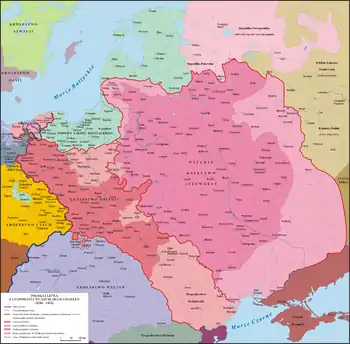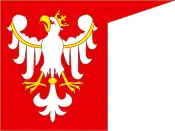Kingdom of Poland (1385–1569)
The Kingdom of Poland (Polish: Królestwo Polskie; Latin: Regnum Poloniae) and the Grand Duchy of Lithuania joined in a personal union established by the Union of Krewo (1385). The union was transformed into a closer one by the Union of Lublin in 1569, which was shortly followed by the end of the Jagiellon dynasty, which had ruled Poland for two centuries.
Kingdom of Poland | |||||||||
|---|---|---|---|---|---|---|---|---|---|
| 1385–1569 | |||||||||
 The Kingdom of Poland (in red) between 1386 and 1434 | |||||||||
| Capital | Kraków | ||||||||
| Official languages | Latin (official) Polish | ||||||||
| Common languages | Ruthenian, German, Yiddish | ||||||||
| Religion | Roman Catholicism (state) | ||||||||
| Government | Hereditary Monarchy | ||||||||
| Monarch | |||||||||
• 1385–1389 | Jadwiga (first) | ||||||||
• 1548–1569 | Sigismund II (last) | ||||||||
| Legislature | Sejmik | ||||||||
| Senate | |||||||||
| Historical era | Middle Ages | ||||||||
| 14 August 1385 | |||||||||
| 3 May 1505 | |||||||||
| 1 July 1569 | |||||||||
| Population | |||||||||
• 1500[2] | 3,900,000 | ||||||||
| Currency | Ducats, Rhenish guilders Polish złoty (from 1496) Red złoty (from 1526) | ||||||||
| ISO 3166 code | PL | ||||||||
| |||||||||
History
The rule of the Jagiellonian dynasty in Poland between 1386 and 1572 spans the late Middle Ages and early Modern Era in European history. The dynasty was founded by the Lithuanian Grand Duke Jogaila (Władysław II Jagiełło), whose marriage to Queen Jadwiga of Poland formed a Polish–Lithuanian union. The partnership brought vast territories controlled by the Grand Duchy of Lithuania into Poland's sphere of influence and proved beneficial for both the Polish and Lithuanian people, who coexisted and cooperated in one of the largest political entities in Europe for the next four centuries.
In the Baltic Sea region, Poland maintained an ongoing conflict with the Teutonic Knights. The struggles led to a major battle, the Battle of Grunwald of 1410, but there was also the milestone Peace of Thorn of 1466 under King Casimir IV Jagiellon; the treaty created the future Duchy of Prussia. In the south, Poland confronted the Ottoman Empire and the Crimean Tatars, and in the east helped Lithuania fight the Grand Duchy of Moscow. Poland's and Lithuania's territorial expansion included the far north region of Livonia.
In the Jagiellonian period, Poland developed as a feudal state with a predominantly agricultural economy and an increasingly dominant landed nobility. The Nihil novi act adopted by the Polish Sejm in 1505 transferred most of the legislative power in the state from the monarch to the Sejm. This event marked the beginning of the period known as "Golden Liberty", when the state was ruled by the "free and equal" members of the Polish nobility.
Protestant Reformation movements made deep inroads into Polish Christianity, which resulted in unique policies of religious tolerance in the Europe of that time. The European Renaissance as fostered by the late Jagiellonian Kings Sigismund I the Old and Sigismund II Augustus resulted in an immense cultural flowering (see Renaissance in Poland).
Economy
The economy of renaissance Poland was dominated by feudal agriculture.
Military
Culture
The Renaissance in Poland lasted from the late 15th to the late 16th century and is widely considered to have been the Golden Age of Polish culture. Ruled by the Jagiellonian dynasty, the Crown of the Kingdom of Poland (from 1569 part of the Polish–Lithuanian Commonwealth) actively participated in the broad European Renaissance. The multinational Polish state experienced a period of cultural growth thanks in part to a century without major wars, aside from conflicts in the sparsely-populated eastern and southern borderlands. The Reformation spread peacefully throughout the country (giving rise to the Polish Brethren), and living conditions improved, cities grew, and exports of agricultural products enriched the population, especially the nobility (szlachta), who gained dominance in the new political system of Golden Liberty.
Geography and administrative divisions
See also
| Wikimedia Commons has media related to Poland under the Jagiellon Dynasty. |
References
- "Gaude Mater Polonia Creation and History". Retrieved 14 November 2017.
- Samsonowicz, Henryk (1997). "Probe einer demograpischen Einschätzung Polen um das Jahr 1500". Studia Historiae Oeconomicae (in German). 22: 17–24.

